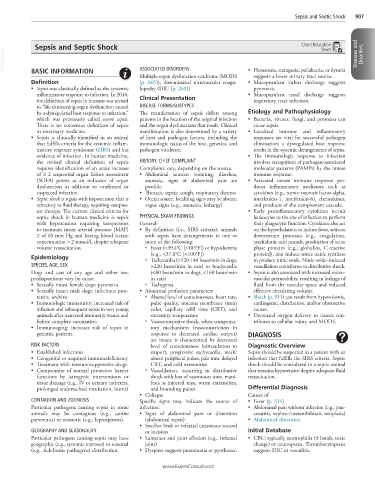Page 1811 - Cote clinical veterinary advisor dogs and cats 4th
P. 1811
Sepsis and Septic Shock 907
Sepsis and Septic Shock Client Education
Sheet
VetBooks.ir Diseases and Disorders
ASSOCIATED DISORDERS
BASIC INFORMATION
Multiple organ dysfunction syndrome (MODS • Hematuria, stranguria, pollakiuria, or dysuria
suggests a lower urinary tract source.
Definition [p. 665]), disseminated intravascular coagu- • Mucopurulent vulvar discharge suggests
• Sepsis was classically defined as the systemic lopathy (DIC [p. 269]) pyometra.
inflammatory response to infection. In 2016, Clinical Presentation • Mucopurulent nasal discharge suggests
the definition of sepsis in humans was revised respiratory tract infection.
to “life-threatening organ dysfunction caused DISEASE FORMS/SUBTYPES
by a dysregulated host response to infection,” The manifestation of sepsis differs among Etiology and Pathophysiology
which was previously called severe sepsis. patients in the location of the original infection • Bacteria, viruses, fungi, and protozoa can
There is no consensus definition of sepsis and the organ dysfunctions that result. Clinical cause sepsis.
in veterinary medicine. manifestation is also determined by a variety • Localized immune and inflammatory
• Sepsis is clinically identified in an animal of host and pathogen factors, including the responses are vital for successful pathogen
that fulfills criteria for the systemic inflam- immunologic status of the host, genetics, and elimination; a dysregulated host response
matory response syndrome (SIRS) and has pathogen virulence. results in the systemic derangements of sepsis.
evidence of infection. In human medicine, • The immunologic response to infection
the revised clinical definition of sepsis HISTORY, CHIEF COMPLAINT involves recognition of pathogen-associated
requires identification of an acute increase Complaints vary, depending on the source. molecular patterns (PAMPs) by the innate
of ≥ 2 sequential organ failure assessment • Abdominal sources: vomiting, diarrhea, immune response.
(SOFA) points as an indicator of organ anorexia, signs of abdominal pain are • Activated innate immune response pro-
dysfunction in addition to confirmed or possible. duces inflammatory mediators such as
suspected infection. • Thoracic sepsis: cough, respiratory distress cytokines (e.g., tumor necrosis factor-alpha,
• Septic shock is sepsis with hypotension that is • Occult source: localizing signs may be absent; interleukin-1, interleukin-6), chemokines,
refractory to fluid therapy, requiring vasopres- vague signs (e.g., anorexia, lethargy) and products of the complement cascade.
sor therapy. The current clinical criteria for • Early proinflammatory cytokines recruit
septic shock in human medicine is sepsis PHYSICAL EXAM FINDINGS leukocytes to the site of infection to perform
with hypotension requiring vasopressors General: their phagocytic function. Cytokines also act
to maintain mean arterial pressure (MAP) • By definition (i.e., SIRS criteria), animals on the hypothalamus to induce fever, activate
≥ of 65 mm Hg and having blood lactate with sepsis have derangements in one or downstream processes (e.g., coagulation,
concentration > 2 mmol/L despite adequate more of the following: arachidonic acid cascade, production of acute
volume resuscitation. ○ Fever (>39.4°C [>103°F]) or hypothermia phase proteins [e.g., globulins, C-reactive
(e.g., <37.8°C [<100°F]) protein]), and induce nitric oxide synthase
Epidemiology ○ Tachycardia (>120-140 beats/min in dogs; to produce nitric oxide. Nitric oxide–induced
SPECIES, AGE, SEX >220 beats/min in cats) or bradycardia vasodilation contributes to distributive shock.
Dogs and cats of any age and either sex; (<80 beats/min in dogs, <160 beats/min • Sepsis is also associated with increased micro-
predispositions vary by cause: in cats) vascular permeability, resulting in leakage of
• Sexually intact female dogs: pyometra ○ Tachypnea fluid from the vascular space and reduced
• Sexually intact male dogs: infectious pros- • Abnormal perfusion parameters effective circulating volume.
tatitis, orchitis ○ Altered level of consciousness, heart rate, • Shock (p. 911) can result from hypovolemic,
• Immunologic immaturity: increased risk of pulse quality, mucous membrane (mm) cardiogenic, distributive, and/or obstructive
infection and subsequent sepsis in very young color, capillary refill time (CRT), and causes.
animals after maternal immunity wanes and extremity temperature • Decreased oxygen delivery to tissues con-
before complete vaccination ○ Vasoconstrictive shock, when compensa- tributes to cellular injury and MODS.
• Immunoaging: increases risk of sepsis in tory mechanisms (vasoconstriction in
geriatric patients. response to decreased cardiac output) DIAGNOSIS
are intact, is characterized by decreased
RISK FACTORS level of consciousness (obtundation to Diagnostic Overview
• Established infections stupor), progressive tachycardia, weak/ Sepsis should be suspected in a patient with an
• Congenital or acquired immunodeficiency absent peripheral pulses, pale mm, delayed infection that fulfills the SIRS criteria. Septic
• Treatment with immunosuppressive drugs CRT, and cold extremities shock should be considered in a septic animal
• Compromise of normal protective barrier ○ Vasodilation, occurring in distributive that remains hypotensive despite adequate fluid
functions by iatrogenic interventions or shock with loss of vasomotor tone, mani- resuscitation.
tissue damage (e.g., IV or urinary catheters, fests as injected mm, warm extremities,
prolonged endotracheal intubation, burns) and bounding pulses Differential Diagnosis
• Collapse Causes of
CONTAGION AND ZOONOSIS Specific signs may indicate the source of • Fever (p. 334)
Particular pathogens causing sepsis in some infection: • Abdominal pain without infection (e.g., pan-
animals may be contagious (e.g., canine • Signs of abdominal pain or distention creatitis, nephro-/ureterolithiasis, neoplasia)
parvovirus) or zoonotic (e.g., leptospirosis). (abdominal sepsis) • Abdominal distention
• Swollen limb or infected cutaneous wound
GEOGRAPHY AND SEASONALITY or incision Initial Database
Particular pathogens causing sepsis may have • Lameness and joint effusion (e.g., infected • CBC: typically neutrophilia (± bands, toxic
geographic (e.g., systemic mycoses) or seasonal joint) change) or neutropenia. Thrombocytopenia
(e.g., tick-borne pathogens) distribution. • Dyspnea suggests pneumonia or pyothorax. suggests DIC or vasculitis.
www.ExpertConsult.com

